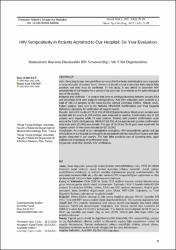| dc.contributor.author | Bahçeci, İlkay | |
| dc.contributor.author | Yıldız, İlknur Esen | |
| dc.date.accessioned | 2022-12-14T05:31:52Z | |
| dc.date.available | 2022-12-14T05:31:52Z | |
| dc.date.issued | 2021 | en_US |
| dc.identifier.citation | Bahçeci, İ. & Yıldız, İ. E. (2021). HIV Seropositivity in Patients Admitted to Our Hospital: Six Year Evaluation. Duzce Medical Journal, 23(1), 25-29. https://doi.org/10.18678/dtfd.846964 | en_US |
| dc.identifier.issn | 1307-671X | |
| dc.identifier.uri | https://doi.org/10.18678/dtfd.846964 | |
| dc.identifier.uri | https://hdl.handle.net/11436/7272 | |
| dc.description.abstract | Aim: Detecting human immunodeficiency virus (HIV)-infected individuals is very important in terms of quality of patients’ lives. However, it should be kept in mind that there may be false positives and tests must be confirmed. In this study, it was aimed to determine HIV seropositivity in our hospital for a period of six years and to contribute to the epidemiological data of the country. Material and Methods: The samples that came to serology laboratory between January 2014 and December 2019 were analyzed retrospectively. Anti-HIV antibodies were screened in a total of 180,413 samples by the macro-ELISA method (Architect i2000sr, Abbott, USA). Patient samples were sent to the National HIV/AIDS Confirmation and Viral Hepatitis Reference Laboratory for verification of reagents results. Results: Anti-HIV results of 178 (0.1%) of 180,413 patients whose blood serum samples were studied with the macro-ELISA method were evaluated as reactive. Confirmation test of 102 patients were negative while 76 were positive. Patients with positive confirmation result account for 0.04% of all patients. While 67 (88.2%) of the patients with positive confirmation were male and 9 (11.8%) were female. The ages of 26-35 and 36-45 years were equal with the highest number of new cases detected (n=20, 26.3%). Conclusion: As a result of our retrospective evaluation, HIV seropositivity, gender and age distributions in our hospital were found to be compatible with the data of our country and other studies conducted in our country. The high false positivity rate of screening tests, again indicates the importance of confirmation tests. | en_US |
| dc.language.iso | eng | en_US |
| dc.publisher | Duzce University | en_US |
| dc.rights | info:eu-repo/semantics/openAccess | en_US |
| dc.subject | Anti-HIV | en_US |
| dc.subject | ELISA | en_US |
| dc.subject | HIV verification | en_US |
| dc.title | Hiv seropositivity in patients admitted to our hospital: Six year evaluation | en_US |
| dc.title.alternative | Hastanemize başvuran hastalardaki hiv seropozitifliği: Altı yıllık değerlendirme | en_US |
| dc.type | article | en_US |
| dc.contributor.department | RTEÜ, Tıp Fakültesi, Temel Tıp Bilimleri Bölümü | en_US |
| dc.contributor.institutionauthor | Bahçeci, İlkay | |
| dc.contributor.institutionauthor | Yıldız, İlknur Esen | |
| dc.identifier.doi | 10.18678/dtfd.846964 | |
| dc.identifier.volume | 23 | en_US |
| dc.identifier.issue | 1 | en_US |
| dc.identifier.startpage | 25 | en_US |
| dc.identifier.endpage | 29 | en_US |
| dc.relation.journal | Duzce Medical Journal | en_US |
| dc.relation.publicationcategory | Makale - Uluslararası Hakemli Dergi - Kurum Öğretim Elemanı | en_US |


















